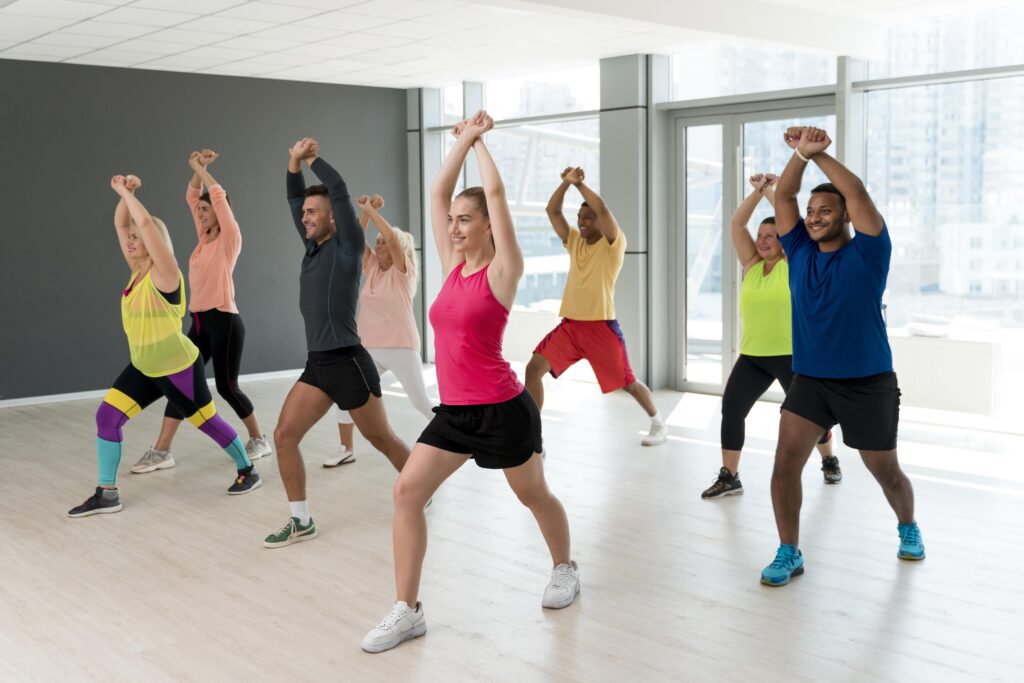Aerobic exercise, often known as steady-state cardio, is done at a slow to moderate speed. Doing aerobic exercises on daily basis brings many advantages that make our health better.

Aerobic exercise is a type of cardiovascular exercise that gets your heart racing. Your blood circulates fast throughout your body during aerobic activity, and your lungs take in more oxygen.
The word aerobic means “with oxygen,” implying that the amount of oxygen delivered to your muscles is determined by your breathing. Your muscles need oxygen to move, which gives you the strength to exercise. Your body generates this energy by combining stored carbohydrates, proteins, and lipids with oxygen.
Aerobic workouts are a group of physical activities that aid in weight loss and the rapid burning of abdominal fat. Aerobic activities for weight loss may be performed at home with little to no workout equipment.
The American Heart Association and most doctors advise those with or at risk of heart disease to engage in aerobic exercise. This is because exercise strengthens your heart and allows it to circulate blood more effectively throughout your body.
By elevating high-density lipoprotein (HDL) cholesterol and reducing low-density lipoprotein (LDL) cholesterol levels in the blood, cardiovascular exercise can help decrease blood pressure and keep arteries free.
Aerobic exercise has been shown to improve memory, contribute to healthy brain aging and increase cognitive performance. 55 older persons had their magnetic resonance imaging (MRI) images evaluated to test this notion. The participants’ health, especially their aerobic fitness, was then assessed. The frontal, parietal, and temporal portions of the brain revealed fewer decreases in the fittest people. Their brain tissue was more strong overall.
More disease-fighting cells, such as white blood cells and substances called cytokines, begin circulating through your circulation shortly after physical exercise. Infections and dangerous organisms in your body are targeted by these.
A small research of persons aged 66 to 84 revealed that the more exercise they did as part of their daily routines, the less likely they were to get upper respiratory illnesses such as colds and flu, and the shorter the duration of these diseases.
Regular runners may also have a decreased risk of pneumonia and lung disease death than non-runners.
Aerobic exercise has been shown to enhance sleep quality in persons with insomnia in studies. If the only time you have to get in aerobic activity is immediately before bed, research shows that doing so won’t harm your sleep quality and may even help you get a better night’s sleep.

Adults should strive for at least 150 to 300 minutes of moderate-intensity exercise or 75 to 150 minutes of intense physical activity each week, according to the Department of Health and Human Services’ Physical Activity Guidelines for Americans. The first recommendation would include aerobic activity, while the second would focus on high-intensity interval training (HIIT).
All you need is a jumping rope for this simple sport that you can do anywhere, at any time. This exercise can help with balance, coordination, and agility. If you do this exercise for 25-30 minutes on daily basis, you will undoubtedly lose weight.
The most well-known form of cardio is certainly running. This workout is beneficial for people of all ages; it is frequently included in athlete regimens, but it may also be beneficial for novices.

Stair climbing is an excellent workout for beginners who want to improve their leg strength and resistance. Combine this with other aerobics at least twice a week for 30 minutes.
Biking is a simple kind of exercise that even children like. When done on inclining roadways, it enhances balance, skill, and resistance.
Swimming is an enjoyable cardiovascular workout for weight reduction that may burn 510 calories in an hour for a person weighing 60 to 70 kg. If you’re a beginner at swimming, start with 10 laps of freestyle strokes to make sure you’re using all of your muscles. Learn different strokes as well to get the most out of swimming.
Walking for 30 minutes per day is another simple aerobic workout that might help you lose weight. You should wear breathable clothing and comfortable shoes, and warm-up for five minutes before beginning. The optimum time to walk is early in the morning, but you may also walk in the evenings if that is more convenient for you. Begin walking at a 5-mile-per-hour pace and progressively build to 7 miles per hour. Slow down to 4 miles per hour at the conclusion of your set to allow your body to calm down.
If you’re a beginner, performing aerobics with a small group will be much more amazing. To make it more enjoyable, encourage your family to attend as you follow an online dancing class instruction and show off your abilities.
Moreover, dancing is frequently used as a weight-loss activity. Aerobic dancing workouts for weight loss can be done in groups or at home. A one-hour dancing program can help you burn 330 calories, lose weight, and strengthen your muscles all at the same time.
Related Articles
Oily Scalp: Causes and Treatments
How To Deal With COVID-Related Hair Loss?
Keratin Treatment For Hair: What Should You Know?
Food Allergy Vs Food Intolerance: Here’s What Most People Don’t Know